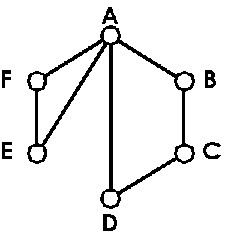Simplify the expression. ÷
÷ 
A. 
B. 
C. 
D. 
Answer: B
You might also like to view...
Let A = {0, 2, 4, 6, 8, 10}, B = {0, 3, 6, 9}, C = {0, 1, 2, 3, 4, 5, 6, 7, 8, 9, 10}, and D = {0, 4, 8}. Determine if the statement is true or false.D ? D
A. True B. False
Use Fleury's algorithm to find an Euler circuit for the graph beginning and ending at the indicated vertex. If no Euler circuit exists, state this.Using the following graph, find an Euler circuit that begins and ends with vertex C.
A. C ? D ? A ? E ? F ? A ? B ? C B. C ? D ? A ? E ? F ? A ? B ? C ? D C. No Euler circuit exists. D. C ? D ? A ? E ? F ? A ? B
Test the equation for symmetry with respect to the specified axis, line, or pole.r = 4 - 4 cos ?; the y-axis 
A. Symmetric about the y-axis B. May or may not be symmetric about the line y-axis
Determine i) the domain of the function, ii) the range of the function, iii) the domain of the inverse, and iv) the range of the inverse.f(x) = 
A. f(x): D =  , R is all real numbers;
, R is all real numbers;
f-1(x): D is all real numbers, R = 
B. f(x): D =  , R =
, R =  ;
;
f-1(x): D =  , R =
, R = 
C. f(x): D =  , R =
, R =  ;
;
f-1(x): D =  , R =
, R = 
D. f(x): D =  , R =
, R =  ;
;
f-1(x): D is all real numbers, R = 